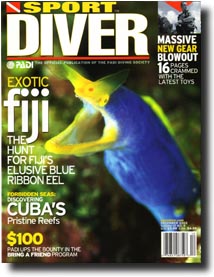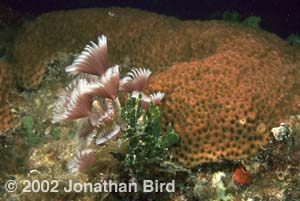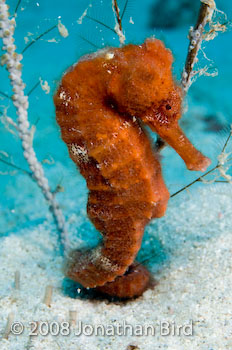
|
Depth of Field: Is more always better? Note: This photo tip
page requires a firm grasp of the concepts
of depth of field and how it is
correlated to focal length and
aperture. I'm assuming the reader
has a basic knowledge of these concepts.
Any good photography book (not just
underwater ones) will cover this in enough
detail to bring readers up to speed for
this photo tip. (Yes, this article was written before the digital age, but the concepts are still 100% accurate.) Obviously, I hang around a lot of
underwater photographers. I lead photo
trips, teach photo classes, give out
advice (sometimes unwanted!) and hear a
lot of underwater photographers talk
photography. I'm often surprised how most
people discuss depth of field. It is
obvious to me that many of them understand
the concept but not the application of
depth of field in underwater
photography. When we're talking about having money,
more is always better, but when we're
talking about depth of field, more is not
always better. Often it is better, yes.
Always? Hell no. Many photographers never
shoot a macro lens any wider than f/16.
They buy the largest flash units in the
world so they can blind everything
shooting at f/22, or in the case of an
extreme macro lens, effectively at f/44 or
f/64. Why? "Because more depth of field is
better" they say. Why? I'm here to tell you that more is not
always better. Before I argue the point,
let me start with a story. Once upon a
time there was a fantastic underwater
camera called a Nikonos. Unfortunately, it
was not an SLR, so the photographer could
not actually see through the same lens
that the film would be exposed through.
It's what we call a rangefinder camera,
meaning that the photographer looks
through a window on the top of the camera
that approximates the view of the camera.
Because the viewfinder is always in focus
(your eye does the focusing), you can't
tell by looking through the viewfinder if
the lens is focused correctly on the
subject, so you have to guess. If you
guess that something is 4 feet away and
it's actually 5 feet away, the picture
might be out of focus. If you guess 4 feet
and it's actually 4.5 feet, it might be
close enough that the focus will be okay.
With the Nikonos, everyone wants as much
depth of field as possible to compensate
for the inaccuracy in focusing. When
shooting with my Nikonos and 15 mm lens in
open water and ambient light (as I do with
large marine mammals) I like to have
enough depth of field that I won't have to
refocus too often. Sometimes animals are
moving too fast and all I can hope to do
is shoot away and concentrate on
composition. If I know that I have good
depth of field from 3 feet to infinity, I
really don't need to worry at all about
focus unless the animal comes really
close. This is handy. Unfortunately, the Nikonos has taught
generations of underwater photographers
that more depth of field is better. This
has carried over into macro photography
where most people are dealing with
extension tubes or SLR's with autofocus.
In this case, we no longer need depth of
field to compensate for the inaccuracy of
focusing. The Nikonos framer tells us how
far away to put the camera for proper
focus, and the SLR can focus accurately on
the subject. For extreme macro work, (let's pull a
number out of the water here...say 1:3 or
closer) the reproduction ratio of the lens
limits the depth of field significantly,
and most people want to shoot at f/16 or
f/22 to be sure that the subject is in
focus from the front to the back. It can
be kind of annoying to have a fish eye in
focus but the lips (closer to the camera)
out of focus. This is a good time for
maximum depth of field. However, at reproduction ratios
somewhat less than 1:3, shooting with
maximum depth of field can be a detriment
to the image. Why? Having a lot of depth
of field can make the background very
sharp and distract the viewer from the
subject. Furthermore, lenses are sharpest
in the middle of their aperture range
(around f/8). Due to diffraction, at f/22
most lenses are somewhat softer than at
f/8, even though they give more depth of
field. This huge interest in maximum depth of
field is very common in underwater
photographers. It is much less common in
surface photographers. Portrait
photographers rarely shoot at f/22. They
know that a person should stand out from a
background. If you shoot at f/4 to f/8
(depending on the reproduction ratio), you
can get enough depth of field to keep the
entire face in focus but throw the
background out of focus. This is important
because the eye goes to the sharpest thing
in a photograph. If the idea is to draw
one's attention to the face, you don't
want the trees in the background to be
sharp. They distract the viewer and
clutter the photograph. Same thing
underwater. You want the fish in focus and
the background a little soft so the fish
stands out and the background doesn't
interfere. A common trick in television is to run
closing titles of a film over video that
is ever so slightly out of focus, shot
that way on purpose. This makes the titles
very sharp in comparision to the video,
and makes them jump out better and be
easier to read as they scroll by. It's the
same concept. Now here's a real life example. Figure
1 is the cover of Sport Diver
featuring a photograph of mine taken in
Fiji. It's a blue ribbon eel sticking out
of the reef. Many people commented on how
this eel seemed to jump off the page. I
got several questions when this cover came
out from people who wanted to know how I
made it look so three dimensional. I sold
several prints of this image. What was the
trick? No trick. I shot the image at f/8, f/11
and f/16, knowing that if I shot too
stopped-down, the reef in the background
would be in focus and distracting. I
didn't know exactly which f-stop would be
best, so I experimented. When I got the
film back, the f/16 image was too sharp in
the background. I sent the f/8 and f/11
shots to the magazine and the editor chose
the f/8 version (a horizontal) and blew it
up and cropped to a vertical for the
cover. With the face of the eel
razor-sharp, the image was able to be
enlarged and cropped to a vertical no
problem, and with the background nicely
out of focus, the text on the magazine
cover seemed to jump right off the page.
Most photographers when faced with a
situation like this simply set it on f/22
and blast away, because "more depth of
field is better". I can tell you for
certain that the f/16 versions of this
image were not nearly as stunning. They
were not cover material. Without the f/8
version of this shot, I never would have
gotten the cover of this issue.
Furthermore, at f/8 I was only shooting at
1/4 power on the strobes, so they recycled
instantly. Gotta love that! People often think of composition in
terms of 2 dimensions. Think of depth of
field as your 3rd dimension in composition
and think about how much you need to make
the impact you want. I'm not saying that
f/22 is bad. Often f/22 is the best answer
to the depth of field question...but not
always. How about another example? The other
effect you get by opening the aperture (in
addition to a reduction in depth of field)
is an increase in the amount of ambient
light that reaches the film. Most
underwater macro shots have a black,
underexposed background, even when shot in
broad daylight, because at f/22, there is
simply not enough ambient light to
register on the film. By opening up to
f/11 or f/8 and shooting upward slightly,
you can get some nice blue water in the
background of a shot rather than a boring
black background. Well, that's tip #1. I hope you enjoyed
it! Jonathan Figure 1: Blue Ribbon
Eel at f/8. Note that the background is
out of focus, thus making the face of the
eel and the text on the page jump out in a
3D-like effect. Learn underwater
photography on Dive
Adventures
with Jonathan!
|
Last Update 12/20/02



